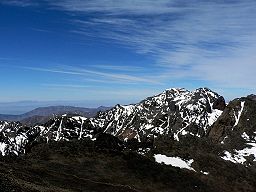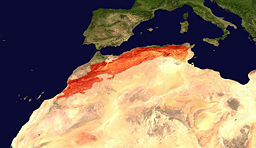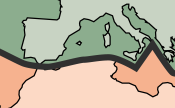Difference between revisions of "Atlas Mountains" - New World Encyclopedia
m (Rename to Geography) |
|||
| Line 17: | Line 17: | ||
}} | }} | ||
| − | The '''Atlas Mountains''' ({{lang-ar| جبال الأطلس }}) are a series of mountain peaks that run along the | + | The '''Atlas Mountains''' ({{lang-ar| جبال الأطلس }}) are a series of mountain peaks that run along the northwestern portion of the African continent, extending through modern day Morocco, Algeria, and Tunisia. The terrain of the Atlas Mountain range is particularly difficult to cross due to its extrememly high peaks, reaching a towering {{convert|4167|m|ft|0}} at its high point [[Jbel Toubkal]] in southwestern Morocco. Other notable peaks are slightly smaller, particualrly mountain M'Goun, which measures 4071 meters. The difficult terrain of the Atlas Mountain Range extends 1,500 miles, and for this reason the range served in the past to geographically seperate the northern coastline of Africa from the Saharan desert. While the range has been passable for many centuries, evidence of the historical divide is still present in cultural and societal differences on opposite sides of the range. |
For ease of discussion and study the Atlas Mountain Range is commonly divided into six seperate ranges: Middle Atlas, High Atlas, Anti-Atlas, Tell Atlas, Saharan Atlas, and the Aurès Mountains. | For ease of discussion and study the Atlas Mountain Range is commonly divided into six seperate ranges: Middle Atlas, High Atlas, Anti-Atlas, Tell Atlas, Saharan Atlas, and the Aurès Mountains. | ||
| + | == Geology == | ||
| + | [[Image:Atlas-Mountains-Labeled-3.jpg|left|thumb|300px|Map showing the location of the Atlas Mountains across North Africa]] | ||
| + | |||
| + | While much of the bedrock ofraced to the African continent was formed in the early Precambrian Era, the foundation of the Atlas Mountain range was formed much later. The beginnings of the Atlas range can be traced to three disctinct stages: | ||
| − | + | Over 80 million years ago, the first phase of Atlas Mountain formation began. This stage consisted of a series of continental collisions between African and Eurasian plates. The collisions forced layers of limestone and sandstone up from the earth, effectively forming the first level of the mountain range. In the section of the Atlas Range termed the High Atlas the continental collisions resulted in extremely high outcroppings of stone. In other areas, such as the Anti-Atlas, only small outcroppings resulted. | |
| + | |||
| + | In the second stage of geological development the earth's crust significantly expanded, resulting in a seperation of many pervious continental formations. When the continents broke apart, many sedmentary basins were formed, including the Atlas Mountain Range. | ||
| − | |||
| − | |||
| − | |||
| − | |||
| − | |||
| − | |||
[[Image:Atlas Mountains tectonic plates.png|thumb|200px|right|The tectonic boundary.]] | [[Image:Atlas Mountains tectonic plates.png|thumb|200px|right|The tectonic boundary.]] | ||
The first phase involves only the [[Anti-Atlas]], which was formed in the [[Paleozoic]] Era (~300 million years ago) as the result of continental [[collision]]s. [[North America]], [[Europe]] and [[Africa]] were connected millions of years ago. The Anti-Atlas mountains are believed to have originally been formed as part of [[Alleghenian orogeny]]. These mountains were formed when Africa and America collided, and were once a chain rivaling today's [[Himalayas]]. Today, the remains of this chain can be seen in the [[Fall line]] in the eastern [[United States]]. Some remnants can also be found in the later formed [[Appalachian Mountains|Appalachians]] in North America. | The first phase involves only the [[Anti-Atlas]], which was formed in the [[Paleozoic]] Era (~300 million years ago) as the result of continental [[collision]]s. [[North America]], [[Europe]] and [[Africa]] were connected millions of years ago. The Anti-Atlas mountains are believed to have originally been formed as part of [[Alleghenian orogeny]]. These mountains were formed when Africa and America collided, and were once a chain rivaling today's [[Himalayas]]. Today, the remains of this chain can be seen in the [[Fall line]] in the eastern [[United States]]. Some remnants can also be found in the later formed [[Appalachian Mountains|Appalachians]] in North America. | ||
| − | + | The last stage of geological development was marked by a massive continental collision between the southern end of the Iberian peninsula and the European plate. However, this continental collision was remarkable different that the first stage of development. When the mountains were first being formed the collisions between continents pushed excess material upwards, forming a mountain ridge along the line of collision. In the the continental collisions that took place in the third stage of development geologists are divided as to whether this type of collision took place. While the most probable method of geological formations involved continental plates sliding over one another, there is very little evidentiary support for this hypothesis. On the other hand, there is also little support for a violent, rock-spewing collision. Geologists are often suprised by how little evidence crust thickening or plate shortening is found in the region. A new theory claims that processes deep within the earth's mantle may have contributed to the development of the Atlas mountain range. | |
| − | + | [http://einstein.uab.es/c_geotectonica/WebAtlas/AtlasLitho.htm]{{Fact|date=February 2007}} Recent studies suggest that deep processes rooted in the Earth's mantle may have contributed to the uplift of the High and Middle Atlas.[http://einstein.uab.es/c_geotectonica/WebAtlas/AtlasLitho.htm] | |
| − | |||
=== Seismic activity === | === Seismic activity === | ||
Revision as of 16:51, 22 September 2007
| Atlas Mountains | |||
|---|---|---|---|
Jbel Toubkal in Toubkal National Park in the High Atlas
| |||
| Countries | Morocco, Algeria, Tunisia | ||
| Highest point | Jbel Toubkal | ||
| - coordinates | coord}}{{#coordinates:31|03|43|N|07|54|58|W|landmark | name=
}} | |
| - elevation | 4,167 meters (13,671 feet) | ||
The Atlas Mountains (Arabic: جبال الأطلس ) are a series of mountain peaks that run along the northwestern portion of the African continent, extending through modern day Morocco, Algeria, and Tunisia. The terrain of the Atlas Mountain range is particularly difficult to cross due to its extrememly high peaks, reaching a towering 4,167 meters (13,671 ft) at its high point Jbel Toubkal in southwestern Morocco. Other notable peaks are slightly smaller, particualrly mountain M'Goun, which measures 4071 meters. The difficult terrain of the Atlas Mountain Range extends 1,500 miles, and for this reason the range served in the past to geographically seperate the northern coastline of Africa from the Saharan desert. While the range has been passable for many centuries, evidence of the historical divide is still present in cultural and societal differences on opposite sides of the range.
For ease of discussion and study the Atlas Mountain Range is commonly divided into six seperate ranges: Middle Atlas, High Atlas, Anti-Atlas, Tell Atlas, Saharan Atlas, and the Aurès Mountains.
Geology
While much of the bedrock ofraced to the African continent was formed in the early Precambrian Era, the foundation of the Atlas Mountain range was formed much later. The beginnings of the Atlas range can be traced to three disctinct stages:
Over 80 million years ago, the first phase of Atlas Mountain formation began. This stage consisted of a series of continental collisions between African and Eurasian plates. The collisions forced layers of limestone and sandstone up from the earth, effectively forming the first level of the mountain range. In the section of the Atlas Range termed the High Atlas the continental collisions resulted in extremely high outcroppings of stone. In other areas, such as the Anti-Atlas, only small outcroppings resulted.
In the second stage of geological development the earth's crust significantly expanded, resulting in a seperation of many pervious continental formations. When the continents broke apart, many sedmentary basins were formed, including the Atlas Mountain Range.
The first phase involves only the Anti-Atlas, which was formed in the Paleozoic Era (~300 million years ago) as the result of continental collisions. North America, Europe and Africa were connected millions of years ago. The Anti-Atlas mountains are believed to have originally been formed as part of Alleghenian orogeny. These mountains were formed when Africa and America collided, and were once a chain rivaling today's Himalayas. Today, the remains of this chain can be seen in the Fall line in the eastern United States. Some remnants can also be found in the later formed Appalachians in North America.
The last stage of geological development was marked by a massive continental collision between the southern end of the Iberian peninsula and the European plate. However, this continental collision was remarkable different that the first stage of development. When the mountains were first being formed the collisions between continents pushed excess material upwards, forming a mountain ridge along the line of collision. In the the continental collisions that took place in the third stage of development geologists are divided as to whether this type of collision took place. While the most probable method of geological formations involved continental plates sliding over one another, there is very little evidentiary support for this hypothesis. On the other hand, there is also little support for a violent, rock-spewing collision. Geologists are often suprised by how little evidence crust thickening or plate shortening is found in the region. A new theory claims that processes deep within the earth's mantle may have contributed to the development of the Atlas mountain range. [1][citation needed] Recent studies suggest that deep processes rooted in the Earth's mantle may have contributed to the uplift of the High and Middle Atlas.[2]
Seismic activity
Because the Atlas mountains lie on the fault zone, the area is seismically active. The city of Blida in Algeria which lies today in the middle of the Tell Atlas with a population of about 265,000 (2005) inhabitants was completely destroyed by strong quakes in the 19th century. Likewise the city of Cheliff lying in Algeria with a population of ~235,000 (2005) inhabitants suffered 5,000 fatalities in a 1980 earthquake of magnitude 7.3 on Richter Scale.
Natural resources
The Atlas are rich in natural resources. There are deposits of iron ore, lead ore, copper, silver, mercury, rock salt, phosphate, marble, anthracite coal and natural gas among other resources.
Subranges of the Atlas Mountains
The range can be divided into three general regions from west to east:
- Middle Atlas, High Atlas, and Anti-Atlas (Morocco).
- Saharan Atlas (Algeria).
- Tell Atlas (Algeria, Tunisia).
Moroccan Atlas ranges
From north to south the Moroccan ranges divide into the Middle Atlas range, the High Atlas range, and the Anti-Atlas range.
Middle Atlas range
The Middle Atlas is part of the Atlas mountain range lying in Morocco, a mountainous country with more than 100,000 km² or 22% of the surface rising above 2,000 meters. The Middle Atlas is the westernmost of three Atlas Mountains chains that define a large plateaued basin extensing eastward into Algeria. South of the Middle Atlas and separated by the Moulouya and Oum Er-Rbia rivers, the High Atlas stretches for 700 km with a succession of peaks among which ten reach above 4,000 meters. North of the Middle Atlas and separated by the Sebou River, the Rif mountains are an extension of the Baetic Cordillera (Baetic mountains, which include the Sierra Nevada) in the south of Spain.
Snow persists in the Middle Atlas in the winter and can appear starting at 600 m above sea level. It is a green and rainy area, with some forests. Its rock coast, particularly beautiful, is not very hospitable. The basin of the Sebou is not only the primary transportation route between Atlantic Morocco and Mediterranean Morocco but is an area, watered by the Middle Atlas range, that constitutes the principal agricultural region of the country.
The Middle Atlas high point is Jbel Bou Naceur (3340 m), then Jbel Mouâsker (3277 m), in the North, and finally Jbel Bou Iblane (3172 m), which lies close to Immouzer Marmoucha.
Because of its elevation, the Middle Atlas experiences snow during the winter months and a cool climate during the summer. The town of Ifrane enjoys sufficient snow during the winter months that it provides accommodations quite rare in Africa; it is a ski resort.
The Middle Atlas includes four major catchment areas:
- Le basin of Sebou: of a surface of approximately 40,000 km², discharging to the Atlantic Ocean.
- Le basin of Oum Errabiaa: extends on a surface from 35,000 km², discharging to the Atlantic Ocean.
- Le basin of Bouregreg: cover a surface of about 10,000 km², discharging to the Atlantic Ocean.
- Le basin of Moulouya: takes its source in the Almssid region and drains both the Middle and the High Atlas, with a watershed of 74,000 km², discharging to the Mediterranean.
The Middle Atlas contributes abundant and the relatively regular flows to these rivers. Reserviors have been developed for flood control, to improve tourism, and to create water reserves supporting the development of the arboriculture important to the agricultural industry of the region.
High Atlas
- Main articles: High Atlas
The High Atlas in central Morocco rises in the west at the Atlantic coast and stretches in an eastern direction to the Moroccan-Algerian border. At the Atlantic and to the southwest the range drops abruptly and makes an impressive transition to the coast and the Anti-Atlas range. To the north, in the direction of Marrakech, the range descends less abruptly.
On the heights of Ouarzazate the massif is cut through by the Draa valley which opens southward. In this chaos of rocks the contrasts are astonishing: water runs in some places, forming clear basins. It is mainly inhabited by Berber people, who live in small villages and cultivate the high plains of Ourika Valley.
The range includes Jbel Toubkal, which at 4,167 m is the highest in the range and lies in Toubkal National Park.
The range serves as a weather system barrier in Morocco running east-west and separating the Sahara's climatic influences, which are particularly pronounced in the summer, from the more Mediterranean climate to the north, resulting in dramatic changes in temperature across the range. In the higher elevations in the range snow falls regularly, allowing winter sports. Snow lasts well into late spring in the High Atlas, mostly on the northern faces of the range.
The High Atlas forms the basins for a multiplicity of river systems. The majority of the year-round rivers flow to the north, providing the basis for the settlements there. A number of wadis and seasonal rivers terminate in the deserts to the south and plateaux to the east of the mountains.

Near Barrage Cavagnac, there is a hydroelectric dam that has created the artificial lake Lala Takerkoust. The lake serves also as a source for fish for the local fishermen.
The largest villages and towns of the area are Tahanaoute, Amizmiz, Asni, Tin Mal, Ijoukak, and Oukaïmden.
Anti-Atlas ranges
- Main article: Anti-Atlas
The Anti-Atlas extends from the Atlantic Ocean in the southwest of Morocco toward the northeast to the heights of Ouarzazate and further east to the city of Tafilalt (altogether a distance of approximately 500 km). In the south it borders the Sahara. The easternmost point of the anti-Atlas is the Djebel Sarhro mountains and its eastern boundary is set by sections of the High Atlas range.
Saharan Atlas range
- Main article: Saharan Atlas
The Saharan Atlas of Algeria is the eastern portion of the Atlas mountain range. Not as high as the Grand Atlas they are far more imposing than the Tell Atlas range that runs to the north of them and closer to the coast. The tallest peak in the range is the 2236 m high Djebel Aissa. They mark the northern edge of the Sahara Desert. The mountains see some rainfall and are better suited to agriculture than the plateau region to the north. Today most of the population of the region are Berbers.
Tell Atlas range
- Main article: Tell Atlas

The Tell Atlas is a mountain chain over 1,500 kilometers in length, belonging to the Atlas mountain ranges and stretching from Morocco, through Algeria to Tunisia. It parallels the Mediterranean coast. Together with the Saharan Atlas to the south it forms the northernmost of two more or less parallel ranges which gradually approach one another towards the east, merging in Eastern Algeria. At the western ends at the Middle Atlas range in Morocco. The area immediately to the south of this range is high plateau, with lakes in the wet season and salt flats in the dry.
Aurès mountain range
- Main article: Aurès Mountains
The Aurès Mountains of Algeria and Tunisia are the furthest eastern portion of the Atlas mountain range.
See also
- Capsian culture
- North Africa
- Africa
References and notes
External links
Credits
New World Encyclopedia writers and editors rewrote and completed the Wikipedia article in accordance with New World Encyclopedia standards. This article abides by terms of the Creative Commons CC-by-sa 3.0 License (CC-by-sa), which may be used and disseminated with proper attribution. Credit is due under the terms of this license that can reference both the New World Encyclopedia contributors and the selfless volunteer contributors of the Wikimedia Foundation. To cite this article click here for a list of acceptable citing formats.The history of earlier contributions by wikipedians is accessible to researchers here:
The history of this article since it was imported to New World Encyclopedia:
Note: Some restrictions may apply to use of individual images which are separately licensed.




